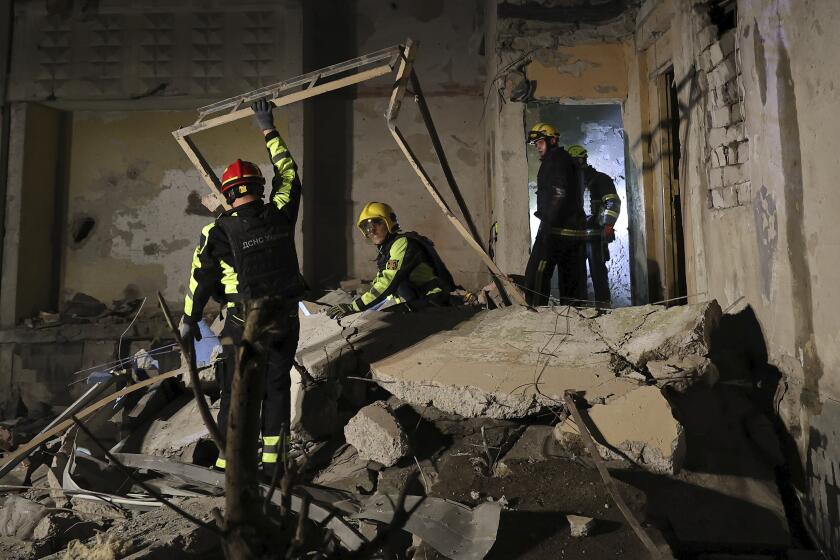From the archives: Danube ‘Blues’ Alter Politics for Hungarians
NAGYMAROS, Hungary -- One cool spring day in 1980, Janos Vargha, a biologist-turned-journalist, visited a village on the Danube and was asked a question that would alter politics in Hungary forever.
Vargha, 44, had been sent to report on pristine wetlands along the river’s banks. But the townspeople had a more pressing topic on their minds.
“What about the dam?” they asked Vargha, clustering around him anxiously.
“What dam?” he responded.
Vargha soon found out. It was a behemoth of a hydroelectric power plant to be built upstream at the town of Nagymaros, involving 30 years of planning, $800 million in projected costs and a complex web of financing with Austria and Czechoslovakia.
And although Vargha had never heard of the project before, the dam was already beginning to worry some scientists. They said it would cost too much, produce too little and destroy one of Hungary’s most scenic resort areas in the process.
Nine years later, Vargha has emerged as the father of a nationwide environmental movement focused on stopping the dam. The Danube Circle--Duna Kor in Hungarian--is able to rally thousands of protesters on short notice, including politicians both inside and outside the Communist Party. In May, its efforts led the government to halt construction for several months while it reassesses costs. Today, many say the dam, which is 25% built, will never be finished.
Regardless of the outcome, the campaign has established Hungary’s “Blues” as the most organized and articulate environmental movement east of Western Europe’s “Greens” territory.
The Danube Circle’s lobbying powers are especially impressive for the East Bloc, where ecology has long been dismissed as a “bourgeois” science.
The debate over whether to scrap the dam also promises to test the sincerity of Hungary’s Communist leaders, who claim they want to right Stalinist wrongs and end government secrecy. In the last year, the dam controversy has mushroomed into one of the party’s biggest nightmares.
“I wake up at 5 a.m. thinking about Nagymaros,” Miklos Nemeth, Hungary’s premier, told Parliament earlier this summer.
At that same session, several Parliament members invoked Nagymaros to demand that Environmental Minister Laszlo Marothy resign because, they said, he had misled the government about the dam’s danger.
Many say that Vargha helped bring about this open debate. They also praise the one-time journalist for focusing environmental concerns around a symbol all Hungarians can relate to--the free-flowing Danube and its lush, green banks.
“Vargha will figure as an important man in Hungarian history. He has played a very great role,” says Janos Szentagothai, a member of Parliament and former president of the Hungarian Academy of Sciences.
Today, people throughout Budapest wear the Danube Circle’s blue-and-white circle pins. The group, which numbers only 170 official members, has collected 130,000 signatures on a petition against the dam and has called for a national referendum on the issue.
Since his meeting with the villagers nine years ago, Vargha has discovered that Hungary had been flirting with the idea of a Danube dam since the 1950s. In 1977, the government signed a contract authorizing Austrian firms to build the dam at Nagymaros, about one hour’s drive north of Budapest, in exchange for 20 years worth of hydroelectric power.
During this time, the Hungarians also signed an agreement with the Czechoslovaks, who were building their own dam at Gabcikovo in Bratislava. To attain full generating capacity, the two dams need to be operated in cooperation with one another.
Things might have ended there, except that when Vargha started digging, he found the Hungarian Water Authority extremely defensive and close-mouthed.
“All our questions were handled in secret,” Vargha recalled. “The interest groups behind the project were really afraid.”
Gabor Lovei, a Danube Circle member and biologist at the Academy of Science, says the government was desperate to conceal that some of its own engineers had condemned the project.
“Janos stumbled onto a bitter inner conflict,” Lovei said. “The more he dug, the more it smelled.”
Alliances Forged
Intrigued, Vargha forged alliances with about 15 other concerned scientists and engineers. The little group made pilgrimages to the library and dug up bulletins and journals of the Hungarian Water Authority.
Based on their research, the group concluded that the dam would destroy wetlands and aquatic life, including dozens of rare river species. Opposition hardened when they realized that Hungary would reap few economic benefits, since most of the power would go to Austria.
And some even questioned how much power would be generated. Estimates ran as low as 2% of the national needs.
“In 1981, our engineers and economists said it was unsound and would never pay its costs. But nobody could afford to stand up against the water board,” said Szentagothai, an early critic of the project.
Studies also showed that the dam threatens the fresh water supply of northwest Hungary, in that it would destroy layers of sediment that serve as a natural filtration system for the region’s ground water.
Seismic conditions were a third concern. Geologists said a substantial earthquake could destroy the dam and send monster walls of water racing toward 58 villages that lay downstream.
“As dams go, it certainly belongs on the list of the 10 worst environmental projects in the world,” concluded Konrad von Moltke, a former director at the Institute of European Environmental Policy in Bonn who now teaches at Dartmouth College.
By early 1981, Vargha had completed his research. He wrote an article outlining the dam’s environmental problems for BUVAR, the state-controlled journal of the National Authority for Nature Protection.
To his surprise, the article was suppressed. Not only that, but the government imposed a news blackout on the entire project and barred Vargha from water board meetings.
In 1982, Vargha joined with some scientists to print a samizdat-- an illegal underground newspaper--to disseminate news about the dam. The group also forged an alliance with Austria’s Greens.
The group got a big break in December, 1983, when a respected Hungarian journal called World Economic Weekly published the first story damning the dam.
“At that time, it was a real rare event to publish criticism of a high-level decision,” Vargha recalled. “It was dangerous for them. They played with their jobs.”
Shortly thereafter, Vargha was invited to speak at a club for intellectual dissidents, where there was much interest but little information about the Nagymaros dam.
“We had the belief that if the truth was released and people were informed about the project, it would be enough to stop it,” Vargha said.
What he hoped, the state apparently feared, because it forced the club to disband. So in early 1984, Vargha formed his own club dedicated to the environment and christened it the Danube Circle.
It received an important boost the following year, when Vargha won an award known as the “Alternative Nobel Prize.” The award, which comes with a $25,000 purse, was established by a Swedish baron to recognize significant environmental contributions and is presented each year in the Swedish Parliament.
Vargha says the Hungarian government was shocked.
“I was called into their offices and told it wouldn’t be politically wise to accept the award,” Vargha said.
But he did anyway and used the winnings to bolster the Danube Circle’s activities.
State officials retaliated in 1986 by firing him from his job. Since then, he has supported himself by writing about the environment for alternative journals.
That same year, Budapest demonstrators on a peaceful environmental walk were attacked and arrested by the police. Some of those injured were Greens from Austria, and the incident received extensive coverage in Western Europe.
Throughout it all, Hungary’s government insisted that it was too late to halt construction because of the huge reparations that would be owed if Hungary defaulted on its contracts with Austria and Czechoslovakia. Besides, the Czechoslovaks had completed 80% of their dam and were waiting nervously for the Hungarians to finish Nagymaros.
And the Danube Circle still has staunch opposition. Hungary’s powerful industry lobby supports the dam because it means more jobs. About 117,000 people signed a petition in favor of the dam, including the mayor of Nagymaros, who dreamed of boom-town wealth for his city--population 70,000.
The issue resurfaced at the October, 1988, session of Parliament. There, the Communist-controlled legislative body voted overwhelmingly to continue construction.
But forces were already at work to undermine their decision. Three months later, Hungary approved an unprecedented law giving opposition clubs the right to assemble and demonstrate. This allowed the Danube Circle to renew its criticism of the dam, and the group lost no time arranging demonstrations and press conferences that were broadcast on the increasingly open evening news.
By early June of this year, a number of Parliament members were singing a new tune.
“Nagymaros is an example of totally bad decision-making that happened with the total exclusion of the public. It will cost energy, not create it,” said Parliament member Gezane Banati.
Premier Nemeth only fueled the fire when he announced his fear that Nagymaros would become an “unforgivable mistake that future generations will have to face.”
In hope that the dam will soon be formally scrapped, the Danube Circle has formed an international foundation to help restore the area.
In the meantime, the Circle has taken on other causes. Recently, its lobbying helped close a bauxite mine that was polluting hot springs at Heviz near Balaton Lake, a resort area 100 miles southwest of Budapest.
“Nagymaros was the first, biggest lesson for us,” Vargha says. “But it was only the first.”
Sometimes, however, Hungary’s Blues feel like they’re swimming up a rapidly flowing stream.
“Ecology wasn’t a priority under communism. It was regarded as a bourgeois science in the ‘50s, and so our environmental education level today is very low,” Vargha says.
To complicate matters, many state factories are nearly bankrupt and cannot afford costly environmental precautions. And in Communist Hungary, the monitoring and collecting of data is poor because “for 40 years, the information channels were controlled by the government,” Vargha says.
But no longer. At a recent demonstration, Hungarian reporters and TV cameras trailed Vargha as he milled among thousands of protesters assembling at Vorosmarty Square, where Vargha intoned the Danube Circle’s rallying cry.
“Let there be peace on the Danube. Let everything flow freely and let aggression be far removed.”
More to Read
Sign up for Essential California
The most important California stories and recommendations in your inbox every morning.
You may occasionally receive promotional content from the Los Angeles Times.










